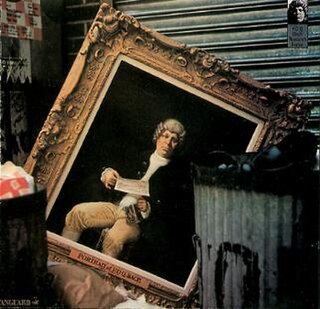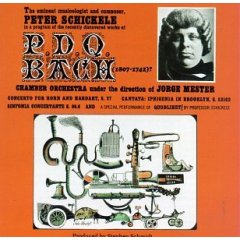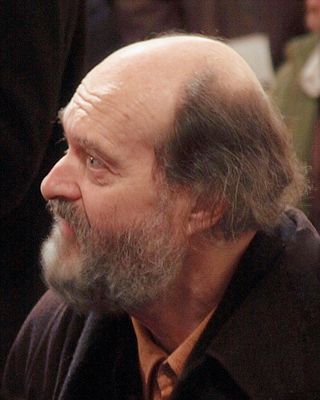Description
In Schickele's own words during the introduction, "The title, Pervertimento is... not P.D.Q. Bach's own. As a matter of fact, it was not so much a title as an opinion of the people who first played it". The piece incorporates several unconventional instruments, and in some cases non-instruments.
The bagpipes player uses three radically different incarnations of the instrument; first, the chanter is removed from the bagpipes and played similar to an oboe or clarinet. "The tone, though jarring, is not altogether unexpected" in the words of the dust jacket for the original LP. In the subsequent movement, a "practice bagpipes" with the drones removed and the chanter muffled is used. In the final movement, the full bagpipes are employed.
Balloons are rubbed and popped through the majority of the piece. For the final chord, three helium balloons, attached to pitchpipes, are released from the percussion section behind the orchestra. The bicycle is "played" first as a percussion instrument using playing cards in the spokes, then by blowing through the handlebars similar to a trumpet, and finally using pedal power to drive a rotary whistle.

Peter Schickele was an American composer, musical educator and parodist, best known for comedy albums featuring his music, which he presented as being composed by the fictional P.D.Q. Bach. He also hosted a long-running weekly radio program called Schickele Mix.

P. D. Q. Bach is a fictional composer created by the American composer and musical satirist Peter Schickele for a five-decade career performing the "discovered" works of the "only forgotten son" of the Bach family. Schickele's music combines parodies of musicological scholarship, the conventions of Baroque and Classical music, and slapstick comedy. The name "P. D. Q." is a parody of the three-part names given to some members of the Bach family that are commonly reduced to initials, such as C. P. E. for Carl Philipp Emanuel Bach; PDQ is an initialism for "pretty damned quick".

Les Luthiers is an Argentine comedy-musical group, very popular also in several other Spanish-speaking countries including Paraguay, Guatemala, Peru, Chile, Ecuador, Spain, Colombia, Mexico, Uruguay, Bolivia, Cuba, Costa Rica and Venezuela. They were formed in 1967 by Gerardo Masana, during the height of a period of very intense choral music activity in Argentina's state universities. Their outstanding characteristic is the home-made musical instruments, some of them extremely sophisticated, which they skillfully employ in their recitals to produce music and texts full of high class and refined humor. From 1977 until his death in 2007, they worked with Roberto Fontanarrosa, a renowned Argentine cartoonist and writer.
The Concerto for Horn and Hardart, S. 27, is a work of Peter Schickele composing under the pseudonym P. D. Q. Bach. The work is a parody of the classical double concerto but where one instrument, the hardart, uses different devices, such as plucked strings, blown whistles and popped balloons, to produce each note in its range. The name "hardart" and the name of the concerto is a play on the name of proprietors Horn & Hardart, who pioneered the North American use of the automat. Like the automat, the hardart had small windows in the front where the musician had to insert coins to remove implements needed to strike or otherwise play the devices that produced the notes. The composer Philip Glass, a classmate of Schickele's, helped build the actual instrument; Glass and the others tasked with building the hardart made it a transposing instrument without telling Schickele, who had to transpose at sight during the performance. As with other works that Schickele attributed to P. D. Q. Bach, "beneath the satire one finds very sound technique and invention in the music."
The Septet in E-flat major for clarinet, horn, bassoon, violin, viola, cello, and double bass, Op. 20, by Ludwig van Beethoven, was sketched out in 1799, completed, and first performed in Vienna in 1800 and published in 1802. The score contains the notation: "Der Kaiserin Maria Theresia gewidmet". It was one of Beethoven’s most popular works during his lifetime, much to the composer's dismay. Several years later, Beethoven even wished the score to have been destroyed, saying: "That damn work! I wish it were burned!"
The ”Grand Serenade for an Awful Lot of Winds and Percussion” is a piece of music written by Peter Schickele, touted as a composition of the fictional P.D.Q. Bach. It consists of 4 movements, and is intended to be humorous to listen to. The players are instructed to play the piece sloppily, especially the fourth movement. The whole piece is about 10–11 minutes long. It was released on the album Music for an Awful Lot of Winds and Percussion.

Report from Hoople: P. D. Q. Bach on the Air was released on Vanguard Records in 1967. It is set up as a radio broadcast of the music of P. D. Q. Bach with Professor Peter Schickele as the DJ.

Portrait of P. D. Q. Bach was released in 1977 on Vanguard Records. The album features mostly the work of Peter Schickele writing as P. D. Q. Bach, with one contribution under his own name.

Peter Schickele Presents an Evening with P. D. Q. Bach (1807–1742)? was the first concert of and the first release of the music of Peter Schickele under his comical pseudonym of P. D. Q. Bach by Vanguard Records. The chamber orchestra was conducted by Jorge Mester. The album consists of musical parodies with commentaries by the composer.

Music for an Awful Lot of Winds and Percussion was released in 1992 by Telarc Records. The album contains one piece by Professor Peter Schickele writing under his own name and several pieces by him as P. D. Q. Bach.

An Hysteric Return: P.D.Q. Bach at Carnegie Hall is live recording of a P. D. Q. Bach concert in Carnegie Hall and was released on Vanguard Records in 1966.

Black Forest Bluegrass is a recording of the music of Peter Schickele under his comic pseudonym of P. D. Q. Bach, featuring the composer and "a bluegrass band with a Baroque orchestra, a wind octet with toys, a commercial with a snake — this album has it all!" The album was released on Vanguard Records in 1979.

A Little Nightmare Music is an opera in "one irrevocable act" by Peter Schickele under the pseudonym he uses for parodies and comical works P. D. Q. Bach. The title of the work refers to the English translation of Mozart's famous Eine kleine Nachtmusik. The opera is described as being "based on a dream he had December 4, 1791, the night that Wolfgang Amadeus Mozart died and Antonio Salieri didn't." The opera was "newly exhumed" at Carnegie Hall on December 27, 1982. It was later recorded with the premiere cast and released on CD by Vanguard Records in 1983. The album also includes two other works by P. D. Q. Bach: an octet and a parody of Handel's Water Music and Music for the Royal Fireworks, Royal Firewater Musick.
The New York Philharmonic concert of April 6, 1962, is widely regarded as one of the most controversial in the orchestra's history. Featuring a performance by Glenn Gould of the First Piano Concerto of Johannes Brahms, conducted by its music director, Leonard Bernstein, the concert became famous because of Bernstein's remarks from the podium prior to the concerto. Before Gould performed, Bernstein disassociated himself from the interpretation that was to come, describing it as "unorthodox" and departing from Brahms' original tempi. Gould, for his part, claimed publicly to be in favor of Bernstein's remarks.
The Echo Sonata for Two Unfriendly Groups of Instruments is a satirical instrumental work written by Peter Schickele under the pseudonym of P.D.Q. Bach, whom Schickele studies as a "scholar".
Jorge Mester is a Mexican conductor of Hungarian ancestry. He has served as the artistic director for the Orquesta Filarmónica de Boca del Río, Veracruz, since it was founded in 2014.

Symphony No. 4 Los Angeles is the fourth symphony by Estonian composer Arvo Pärt. It is the first of his symphonies to be written post-1976 and is in his signature tintinnabuli style. It is the first of his pieces that focuses on larger scale, instrumental tintinnabulation. Previous pieces, such as Summa and Für Alina, were typically written for SATB choir or a smaller number of instruments. Composed in 2008, and premiered 10 January 2009, Symphony No. 4 was nominated for a 2010 Grammy Award for Best Classical Contemporary Composition, although he did not receive the award.
The whirly tube, corrugaphone, or bloogle resonator, also sold as Free-Ka in the 1960s-1970s, is an experimental musical instrument which consists of a corrugated (ribbed) plastic tube or hose, open at both ends and possibly wider at one end (bell), the thinner of which is rotated in a circle to play. It may be a few feet long and about a few inches wide. The faster the toy is swung, the higher the pitch of the note it produces, and it produces discrete notes roughly belonging to the harmonic series, like a valveless brass instrument generates different modes of vibration. However, the first and the second modes, corresponding to the fundamental and the second harmonics, are reported as being difficult to excite. To be played in concert the length of the tube must be trimmed to tune it.
Newton Hart Wayland was an American orchestral conductor, arranger, composer and keyboardist. The product of an elite musical education, Wayland was known for his dedication to performing for the broadest possible audience.









